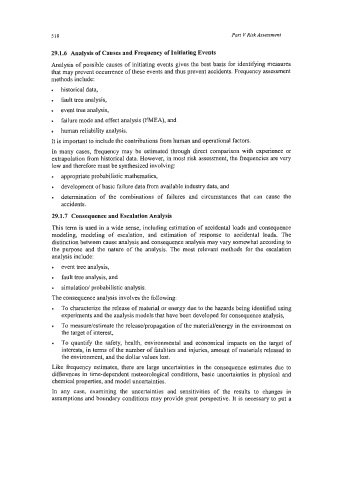Page 542 - Marine Structural Design
P. 542
518 Part V Risk Assessment
29.1.6 Analysis of Causes and Frequency of Initiating Events
Analysis of possible causes of initiating events gives the best basis for identifying measures
that may prevent occurrence of these events and thus prevent accidents. Frequency assessment
methods include:
historical data,
fault tree analysis,
event tree analysis,
failure mode and effect analysis (FMEA), and
human reliability analysis.
It is important to include the contributions from human and operational factors.
In many cases, frequency may be estimated through direct comparison with experience or
extrapolation from historical data. However, in most risk assessment, the frequencies are very
low and therefore must be synthesized involving:
appropriate probabilistic mathematics,
development of basic failure data from available industry data, and
determination of the combinations of failures and circumstances that can cause the
accidents.
29.1.7 Consequence and Escalation Analysis
This term is used in a wide sense, including estimation of accidental loads and consequence
modeling, modeling of escalation, and estimation of response to accidental loads. The
distinction between cause analysis and consequence analysis may vary somewhat according to
the purpose and the nature of the analysis. The most relevant methods for the escalation
analysis include:
event tree analysis,
fault tree analysis, and
simulation/ probabilistic analysis.
The consequence analysis involves the following:
To characterize the release of material or energy due to the hazards being identified using
experiments and the analysis models that have been developed for consequence analysis,
To measurelestimate the releaselpropagation of the materiauenergy in the environment on
the target of interest,
To quantify the safety, health, environmental and economical impacts on the target of
interests, in terms of the number of fatalities and injuries, amount of materials released to
the environment, and the dollar values lost.
Like frequency estimates, there are large uncertainties in the consequence estimates due to
differences in time-dependent meteorological conditions, basic uncertainties in physical and
chemical properties, and model uncertainties.
In any case, examining the uncertainties and sensitivities of the results to changes in
assumptions and boundary conditions may provide great perspective. It is necessary to put a

